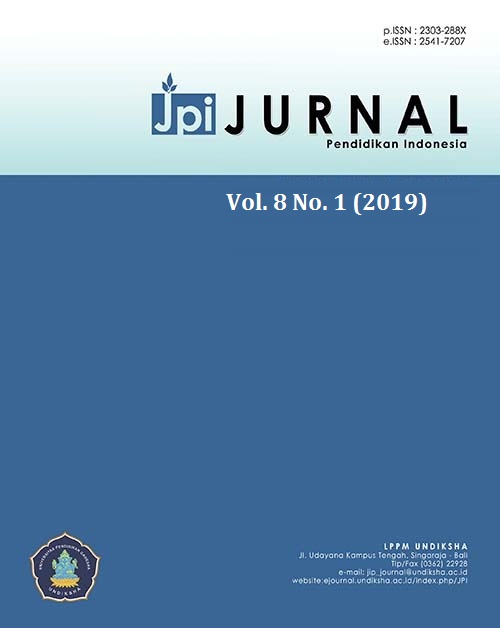Improving Mathematical Critical Thinking and Habits Of Mind To Students in Elementary School
DOI:
https://doi.org/10.23887/jpi-undiksha.v8i1.17822Keywords:
Mathematical critical thinking, students' habits of mindAbstract
This study aims to improve mathematical critical thinking and habits of mind through the application the RAVE-CCC (Read, Attend, Visualize, Estimate, Choice, Calculate, Check) strategy for six grade students of Elementary School. This study uses Classroom Action Research method. The research design used Kemmis and Mc Taggart's model. The research data were collected using field note techniques, interviews, observations, and mathematical critical thinking test and habits of mind questionnaires. The results of this study indicate that, tests of students' mathematical critical thinking show increasing trend in each cycle. In the first cycle, the percentage of students who completed their scores with mathematical critical thinking skills was 70.83% which increases in the second cycle to 83.33%. The percentage of teachers and students activity in each cycle has increased. In the first cycle, the percentage of achievement indicators was 78.57%, in the second cycle, increased to 89.28%. The active participation of all students in the first cycle was 76.19% and in the second cycle increased to 87.5%. As for habits of mind, the percentage in the first cycle and second cycle also increased. In the first cycle the average percentage of students who showed a positive habits of mind was 66.66%, in the second cycle increased to 83.33%. Thus, it can be concluded that the adoption of the RAVE-CCC strategy can improve mathematical critical thinking and habits of mind.
References
Chalkiadaki, A. A Systematic Literature Review of 21st Century Skills and Competencies in Primary Education. International Journal of Instruction, July 2018 Vol.11, No.3 e-ISSN: 1308-1470, p. 6 of 16. http://file.eric.ed.gov/fulltext/EJ1183407.pdf. Accessed 29 Januari 2019.
Costa, A. L. and Kallick, B. (2008). Learning and Leading with Habits of Mind: 16 Essential Characteristics for Success. Boston: ASCD.
Diaz, C. F.; Pelletier, Carol M.; Provenzo; Eugene F. Jr. (2006). Touch The Future Teach. Boston: Pearson.
Eflina. (2013). Penerapan Strategi RAVE-CCC Untuk Meningkatkan Kemampuan Pemecahan Masalah dan Berpikir Logis Matematis Siswa Sekolah Menengah Pertama. Thesis. Bandung: Universitas Pendidikan Indonesia.
Hasanah, I. U. (2018). “Pengaruh Strategi RAVE-CCC Setting Numbered Heads Together Terhadap Peningkatan Kemampuan Pemecahan Masalah Matematis Siswa: Penelitian Kuasi Eksperimen terhadap Siswa Kelas V pada Salah Satu SD di Kecamatan Ujungberung Kota Bandung. Thesis. Bandung: Universitas Pendidikan Indonesia.
Hendriana, H. dan Soemarmo, U. 2014. Penilaian Pembelajaran Matematika. Bandung: Refika Aditama.
Koshy, V; Ernest, P.; Casey, R. (2000). Mathematics for Primary Teaching. New York: Routledge.
Milliyawati, B. (2014). Urgensi Strategi Disposition Habits of Mind Matematis. Infinity Jurnal Ilmiah, 3 (2).
Ministry of Education and Culture. (2016). Process Standards of Basic and Middle Education. Regulation of Education and Culture Minister, No. 22 in 2016
Papadopoulos, I. Using Mobile Puzzles to Exhibit Certain Algebraic Habits of Mind and Demonstrate Symbol-Sense in Primary School Students. Journal of Mathematical Behavior. http://doi.org/10.1016/j.jmathb.2018.07.001.
Suprijono, A. (2016). Model-model Pembelajaran Emansipatoris. Yogyakarta: Pustaka Pelajar.
Yaumi, M & Ibrahim, N. (2013). Pembelajaran Berbasis Masalah Kecerdasan Jamak (Multiple Intelligences). Jakarta: Kencana Prenandamedia Group.
Downloads
Published
Issue
Section
License
Authors who publish with the Jurnal Pendidikan Indnesia agree to the following terms:
- Authors retain copyright and grant the journal the right of first publication with the work simultaneously licensed under a Creative Commons Attribution License (CC BY-SA 4.0) that allows others to share the work with an acknowledgment of the work's authorship and initial publication in this journal.
- Authors are able to enter into separate, additional contractual arrangements for the non-exclusive distribution of the journal's published version of the work (e.g., post it to an institutional repository or publish it in a book), with an acknowledgment of its initial publication in this journal.
- Authors are permitted and encouraged to post their work online (e.g., in institutional repositories or on their website) prior to and during the submission process, as it can lead to productive exchanges, as well as earlier and greater citation of published work. (See The Effect of Open Access)








